Healing with Food and Hoping with Seeds: An Interview with Matt Powers
When Matt Powers sees problems like climate change, hunger, and poverty, he also sees hope. Matt and his family have faced some life-changing challenges. Despite the problems of the world, he knows how much promise lies in seeds, soil, and curious human minds.
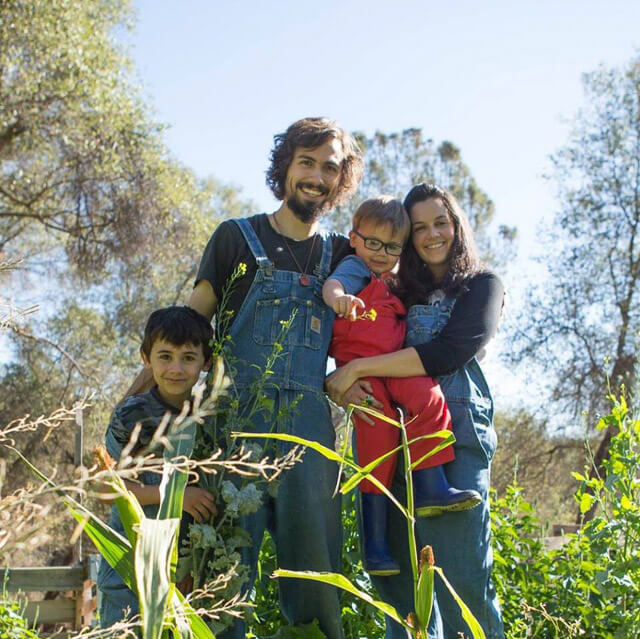
The Powers family in overalls. 🙂 Photo: Matt Powers
Matt is a permaculture educator and author. When I talked with him about his family’s garden and his work, I felt buoyed by his optimism and determination. As you’ll see, Matt has a lot of knowledge and inspiration to share!I’m really excited to share this interview with you.
Amy: Tell me a little about your family and your garden.
Matt: First and foremost, I see myself as a dad and a husband and a steward of the land. The way I include my family in the garden is I have my garden feed my family. I invite them to the garden.
I don’t force my children to be in the garden. It’s an unschooling philosophy–student-centered teaching. You let the student’s passion guide their education.
I try to have the garden be a place of beauty and invitation, so that they’re just drawn to it. And I try to make tons of edibles (I have poisonous stuff, too, and my children know which is which).

Exploring the garden. Photo: Matt Powers
It’s really, really amazing to have a permaculture style garden and orchard (which is called a food forest in permaculture) and allow your children to just grow up knowing that they can create abundance. When you grow up knowing the whole cycle, gardening becomes this place of special beauty.
Permaculture is the only way I could garden in the extreme climate I was in. My garden…my soil last year in Coarsegold, California was 140 degrees two inches deep in the sun. Where I watered in the sun, it was 120. Where I used mulch it was 79 degrees.
So, I learned all these things from permaculture.
Permaculture teaches you the science of ecology in action and how you can interact with it. It’s a lens for viewing our world using nature’s systems to solve problems or grow food or create business or anything, really.
Here’s a video of Matt showing the soil temperature differences:
You and your wife have two boys, right?
I have two sons, a 10 year old and a 6 year old. My wife and I have been married 12 years now. I was a professional musician in New York and she managed a flower shop right around the corner from Wall Street. We met and it was love at first sight. And we were married six months later.
My wife got thyroid cancer in our second year of marriage. It changed the pace and trajectory of my life. We had a young baby and it really catalyzed me.
I’d had a very good education. My dad and my mom both have master’s degrees and they believed in higher education as a must. I was the third born boy in this family of high achievers, and I had all this training.
But I had passively gone through this great education. I didn’t understand what it was. I was one of these children (laughs) who watched the soccer ball go by and I’m looking at the butterfly flying.
So, I went from being asleep most of my life to becoming super charged.
When the doctors started contradicting each other, it sent a fire through my spine. Suddenly, I realized they were reading off scripts and out of books, and they didn’t actually know.
Meanwhile, we have a baby at home and she’s still radioactive. One doctor said she would be safe but the other doctor said she wasn’t safe at all.
I was like, No, no, no. This is my baby; this is my new wife. What’s going on?
It changed everything.
After years of study and therapy, the cancer came back as melanoma from the radiation they’d given her, and then we got cancer again later on.
We had to break the cycle. I had to get the best food. I realized that not all organic is good. If you want good food, you have to grow it! Or you have to have a farmer like Joel Salatin or something.
It changed me overnight and I have never looked back and I never will look back. Because I want to live with my wife as grandparents and see our grandchildren together.
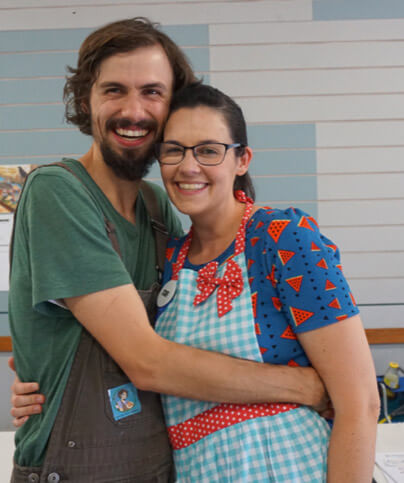
Matt and Adriana. Photo: Matt Powers
Wow! That definitely answers my next question, which was going to be “Why do you garden?” Do you want to add anything to that?
Let me add this. Everyone’s like, “Wait, but I already eat organic.” I discovered that there are these ways we can test organic food to see if it is actually nutritious.
I can take this Brix meter, which is a refractometer. It uses natural light to show you the density of a liquid, that will tell you the starch content and sugar content.
If I take two organic tomatoes [from different farmers], I’ll get readings that tell me who has better soils. I can tell you how healthy it is based on the starch levels of the fruits. Starches and sugars are just carbon chains that tell you how much the plants are photosynthesizing and how stable their foundation is.
I started doing stuff like that, and I was like, wow!
The organic farm is picking their tomatoes green so they stay hard in shipping. They’re not as healthy as the ones I get at the farmer’s market that are fresh and almost rotting. You test those and they’re through the roof.
With organic, there are three things…
- Organic is different when it’s industrial and when it’s local.
- There are people bringing stuff on their property and still calling it organic.
- There are people having a system where they don’t bring in any inputs, they don’t really till, and they’re getting really, really amazing produce.
When you cut the ground, you cut up the fungi, which takes away the economy that plants actually tap into and pick what minerals and nutrients they absorb.
Understanding the difference is why growing food and even the broader picture of sequestering carbon–we could take all this carbon in the air back into our garden soils in our own backyards–we have to do it.
Then, Matt told me more about his journey from musician to teacher to gardener and back to teacher again.
This all happened at the same time. I got a master’s degree in Education. I needed to be close to home, so I taught public education at a K-12 school. The kids only had MacBooks, and I had to create curriculum from scratch. That’s what I’m really good at.
Because I had the summers off, I was able to focus on gardening. I learned everything I could as scientifically as I could about organic gardening. I studied Carol Depp and Elaine Ingham, they’re some of my heroes.
But I couldn’t do it. I could not be a full-time teacher and raise enough food.
I had to change how I did it.
When I saw what Sepp Holzer and Geoff Lawton and Masanobu Fukuoka were doing [with permaculture], my interest was peaked.
I took Geoff Lawton’s permaculture design course after reading Bill Mollison’s Permaculture: A Designers’ Manual. I got a ton out of it.
And I came out of the course thinking this should be made into kids’ curriculum. There are so many kids out there who can use this.
Geoff really encouraged me. He said, Matt, I think you can do it. I think you should do it. I think the fact that you’ve asked means you’re the person.
Whoa, okay!
So I was this curriculum guy, Master’s Degree in Education. I was all into gardening and seed saving. And after years of studying, I understood what I wanted but I didn’t know how to get there. Permaculture really gave me that.
From there, I did a Kickstarter to pay for printing the book. I made three times as much as I asked for–as much as I make in a year as a teacher…in a month! I realized I could become a teacher of THIS.
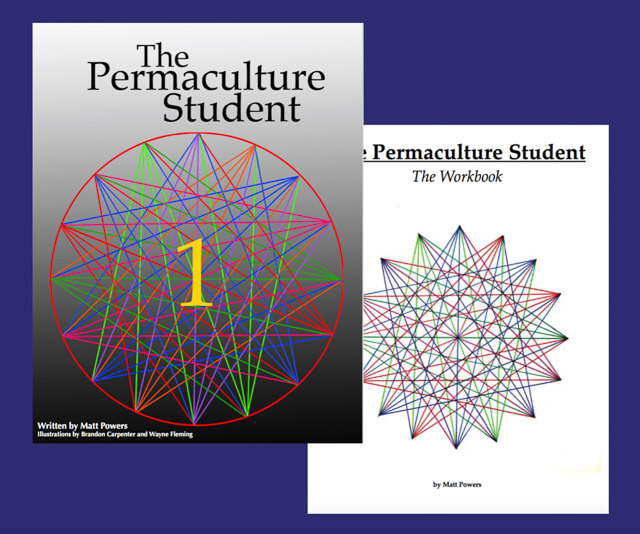
Matt’s first book, Permaculture Student 1, and its workbook companion. Image: Matt Powers
And so Matt started work on his permaculture curriculum for students.
I studied one on one with all the experts in the field over a year and a half. I learned more in that process than I had during any of my education my whole life.
It was wild. I had a lot of help, so that I could be as correct yet as concise as possible. It is actually kind of difficult to take the science and get it down to a simple level without breaking the meaning.
Geoff’s son, Danial Lawton, went over the whole book with me multiple times. Rosemary Morrow, permaculture pioneer, helped me a ton. Elaine Ingham helped me a ton.
I feel really, really grateful for it. My books are translated by volunteers. I have five, almost six, that are done. My books are on every continent but Antarctica. I have a huge outreach program where I share my curriculum with those who can’t afford it, all over the world.
Because this information has to get out there. We’ve got to get everyone growing their own food for their own health. And for the world’s sake.
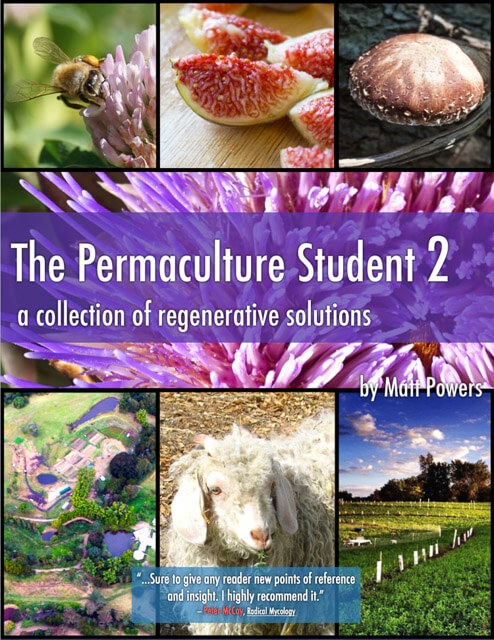
Matt’s second book, The Permaculture Student 2, is full of success stories and examples. Image: Matt Powers
Right on! Let’s get specific. What are your kids’ favorite plants in the garden?
I think peas are Oliver’s favorite because he can identify them easily and he knows he can eat them. He loves eating pea flowers.
I think James’s favorites are raspberries because they’re sweet. And then corn, because he loves opening the corn.
I create landraces of corn and I adapt corn from other parts of the world. Every time you open it, no one has ever seen that. It’s completely new!
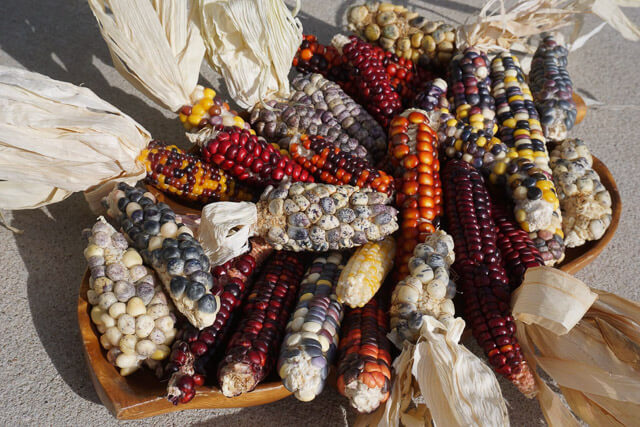
You can see the incredible diversity of Matt’s landraces in this corn harvest. Photo: Matt Powers
Landraces are interbreeding varieties of crops (or livestock) adapted to a specific location. They include bundles of genetic variation within any given seed. As Matt told me, “It is a way of creating something that is true to seed in a totally different way and resilient in a totally different way.”
From there, Matt gave a great comparison of landrace, heirloom, hybrid, and GMO seeds that doesn’t fit here. I’ll definitely revisit his insights in a future article with some specific examples.
What about your favorite plant?
I think my favorite plant is amaranth. It takes such a small little seed and it grows so big. And it’s so happy. It’s so joyous. It’s an expression of triumph, you know?
I really appreciate amaranth and all of the Chenopodia family. I have amaranth that’s 12…14 feet tall. I can get almost a cup of seed from one plant.

Can you spot him in the amaranth patch? Photo: Matt Powers
Matt grew an amaranth relative called huauzontle or red Aztec spinach for seed, which you can buy through Baker Creek and try yourself.
I grew that seed in that 140 degree soil–throw sow–I didn’t cover it. I threw it on bare soil and let it be exposed to the elements and to the animals. It got rained on three times with the early spring rains. That was it. Three months later, it was still green and started making seed.
The whole thing is edible. In times like these, we really need to have something like that growing. You have an area and it’s growing all amaranth and huauzontle. That’s all edible. The leaves are edible, the seeds, the roots. The whole thing. So if anything happened at anytime, you always have food.
The amaranth is a fantastic success. Is there another success you’d want to highlight from your garden?
Sure. One of my greatest successes is that I’m the only person so far (and I want to end this!) to adapt Pisscorunto and Chuspi corn to North America. I did it outside and open-pollinated. I’ll explain how I did it so that other people can do it.
So, I had this daylight-sensitive, photoperiodic corn.
Photoperiodic plants initiate flowering in response to day length. Short-day, long-day, and day-neutral in beans, strawberries and onions are other examples.
So, I had a hill that would like a sundial. The location was blocked by a big tree and the hill during the morning light.
Then, starting around two o’clock in the afternoon, it got full sun until about six. Then it cut off again. It was dappled shade at a weird angle and it never faced directly the sun.
The corn felt like it was back in Peru. I was also at 2000 feet, and the corn felt like it was back in the jungle of the sacred valley. I was able to grow over a dozen ears of white speckled purple corn and it is amazing.
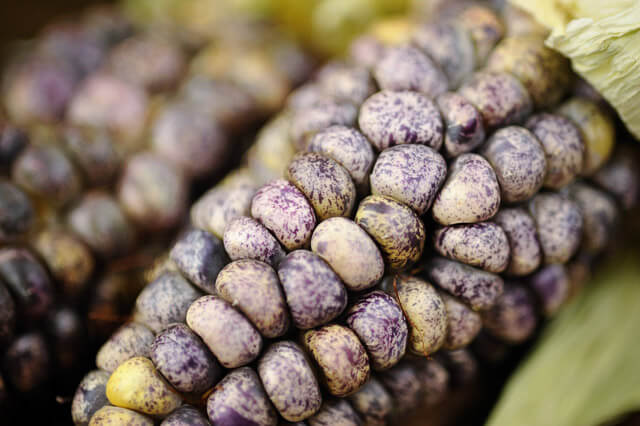
Rare corn, indeed! Photo: Matt Powers
What is your biggest challenge in gardening with kids? And do you have tips for anyone else facing similar?
I think the challenge we’re all going to face is that kids get bored.
They don’t have the patience to reflect and observe all the time. Some children absolutely already have this.
But many children and teens understand it’s important; they just don’t feel motivated by it. That’s why we need to see gardening in a holistic way.
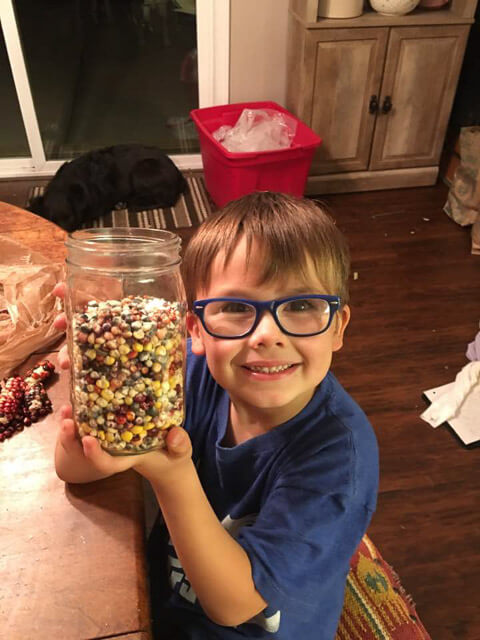
Matt’s youngest son helping with seed saving. Photo: Matt Powers
Someone needs to save the seed. Someone needs to build something to store the seed in–a shed or extra part of the house. (If you’re actually growing enough seed for your family to survive on, you’re going to need something like that.)
Then, what about all of the organic waste? Who’s running the compost and the microscope? Who’s working with fungi? Who’s working with the animals to create the manure to create the compost?
Who’s making the actual plans so you can reverse engineer your diet? That’s a little bit of a word math problem!
I teach that in my course actually, so people can design a garden that would actually feed them. You align what you eat to the yields to the planting to the seeds you plant to the square footage.
All these different things. There are so many layers.
When you think about families in a suburban setting, how do you approach holistic gardens when you have a small backyard?
Because it’s so tight and you can go vertical, suburban and urban people can get more calories per square footage. It’s so intensive.
And you have so much waste–so much water and garbage. If we buy the right stuff, our garbage is just food for the garden. Paper turns into fungi, cardboard turns into fungi, food scraps all turn into vermicompost. We can totally do it.
If you woke up one morning and your beautiful garden had disappeared, replaced by bare dirt and a few amaranth plants, what would you do first and what would you plant first?
Well…I would go investigate why that would be possible.
Matt’s voice was full of disbelief. This re-boot would be highly unlikely for him, since he designed his garden and site with resilience in mind. He even gave me an example.
There was a huge storm event. People’s gardens and houses were washing away. My garden did very well because of my swales. There were hundreds of trees in there.
And then, he humored me and laid out his first steps. 🙂
So, I’d go investigate first.
Then, I would start over.
And the way to start over is you start with pioneer species, like legumes. In the summer, I would plant buckwheat, daikon radish, and cowpeas.
Cowpeas fix the most nitrogen and create the most biomass. Daikon radish are crazy at gathering phosphorous. Buckwheat are good at gathering phosphorus and nitrogen and cause cowpeas to go into overdrive and pull even more nitrogen out of the air.
If it was winter, I’d do fava beans, field peas, and vetch.
Then, I would just put it back together.
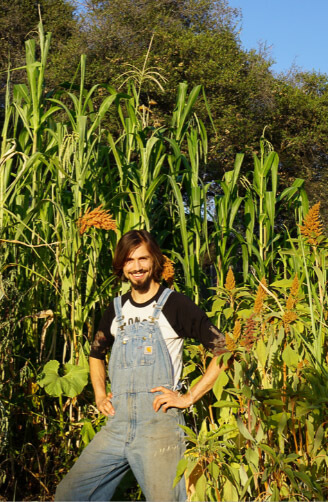
Corn and amaranth might follow Matt’s pioneer species. Photo: Matt Powers
Thank you so much, Matt!
More about Matt Powers
If you’d like to learn more from Matt and explore gardens with him, here’s how to do it:
- Visit his website – permaculturestudent.com
- Follow his videos on Vimeo or YouTube.
- Consider taking one of his courses.
- Read his books, The Permaculture Student 1 and 2
Now, Matt and I would love to hear from you…
How do seeds and soil give you hope? What seeds are you excited about growing this year?
Tell us in the comments below!
